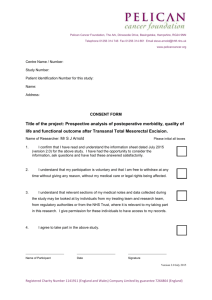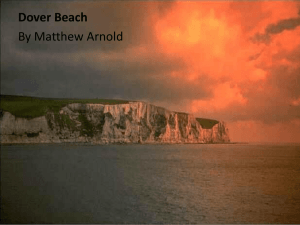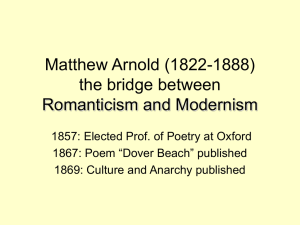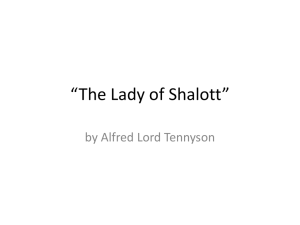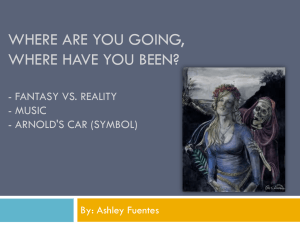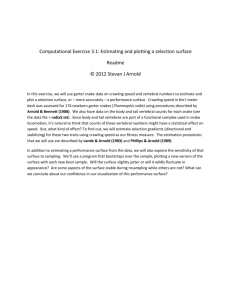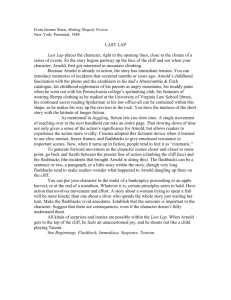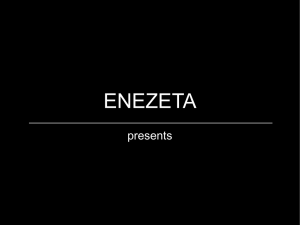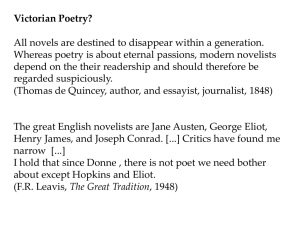Dover Beach and The Lady Of Shallot
advertisement
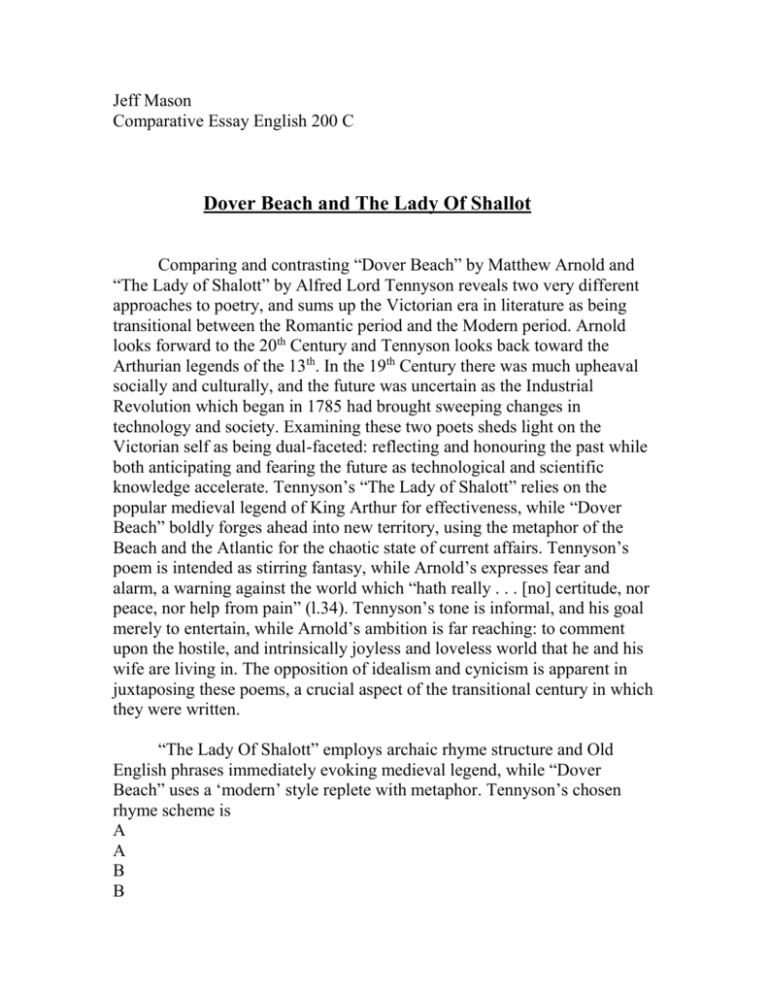
Jeff Mason Comparative Essay English 200 C Dover Beach and The Lady Of Shallot Comparing and contrasting “Dover Beach” by Matthew Arnold and “The Lady of Shalott” by Alfred Lord Tennyson reveals two very different approaches to poetry, and sums up the Victorian era in literature as being transitional between the Romantic period and the Modern period. Arnold looks forward to the 20th Century and Tennyson looks back toward the Arthurian legends of the 13th. In the 19th Century there was much upheaval socially and culturally, and the future was uncertain as the Industrial Revolution which began in 1785 had brought sweeping changes in technology and society. Examining these two poets sheds light on the Victorian self as being dual-faceted: reflecting and honouring the past while both anticipating and fearing the future as technological and scientific knowledge accelerate. Tennyson’s “The Lady of Shalott” relies on the popular medieval legend of King Arthur for effectiveness, while “Dover Beach” boldly forges ahead into new territory, using the metaphor of the Beach and the Atlantic for the chaotic state of current affairs. Tennyson’s poem is intended as stirring fantasy, while Arnold’s expresses fear and alarm, a warning against the world which “hath really . . . [no] certitude, nor peace, nor help from pain” (l.34). Tennyson’s tone is informal, and his goal merely to entertain, while Arnold’s ambition is far reaching: to comment upon the hostile, and intrinsically joyless and loveless world that he and his wife are living in. The opposition of idealism and cynicism is apparent in juxtaposing these poems, a crucial aspect of the transitional century in which they were written. “The Lady Of Shalott” employs archaic rhyme structure and Old English phrases immediately evoking medieval legend, while “Dover Beach” uses a ‘modern’ style replete with metaphor. Tennyson’s chosen rhyme scheme is A A B B C D D D C which is impressively adhered to throughout the poem. This seems strikingly formal and a great achievement poetically, reminiscent of Chaucer or Shakespeare. Tennyson speaks with great authority, aligning himself with older traditions and overall reaching back into the past in a poignant way to describe the curse that dooms the helpless Lady. A fatalistic tale, which echoes the earliest English literature such as Beowulf and vaguely reminiscent of a Norse cosmology in presenting a universe controlled by unsympathetic gods and magical forces such as the curse, which seems to have no logical reason to exist except to torment and finally kill The Lady. In “Dover Beach” Matthew Arnold addresses only his new bride on their honeymoon night, speaking about the sea; the waves near their home, the Aegean that Sophocles contemplated, and the “Sea of Faith” (l.21), a metaphor of Arnold’s invention for the “faith” or “hopes” of the world. To Arnold, it “[brings] the eternal note of sadness in” (l.14) as it casts its waves and pebbles against the shore and from this idea springs the rest of the poem. The Beach is likened to the beach Sophocles stood on when the “turbid ebb and flow/Of human misery” (Arnold l.17) was brought to his mind by the ebb and flow of the waters. The central image of the “Sea of Faith” is derived from this, the “thought” we “find” in the sound of the waves is that the “melancholy, long, withdrawing roar” (Arnold l.25) replaces the Faith that “once . . . round earth’s shore Lay like the folds of a bright girdle furled” (Arnold l.22) These similes, metaphors and personifications are Arnold’s inventions and amount to his own observation of waves crashing on a shore. The rhyme scheme is much less ambitious, and not rigidly adhered to. Some of the lines rhyme and each stanza has its own internal symmetry, creating a much less consistently organized presentation and simply evoking a train of thought. This is a much more direct statement from Arnold to the reader than Tennyson’s reliance on ancient traditions. The Lady of Shalott presents a familiar reassuring theme, a Fairy Tale, while Dover Beach talks about current events in 1851 like the Napoleonic wars and, read in 2007 is darkly ominous, with its famous line about “ignorant armies clashing by night”. This prefigures the catastrophic modern conflicts of the 20th Century (The World Wars) and in retrospect Matthew Arnold was prescient in his premonition of ill omen when worrying about the kind of world he and his wife would live in. He warns his wife against the world which “hath really . . . [no] certitude, nor peace, nor help from pain” (Arnold l.34). Comparing this with The Lady of Shalott, Tennyson’s poem is harmless, decorative entertainment, modeled on older traditions and ornamented in a florid way, overall meant to be easily digestible. There is no historical or social relevance. Arnold’s poem by contrast bewails the state of the modern world, comparing it to “a darkling plain/Swept with confused alarms of struggle and flight” (l.35). His intimation lasts only four short stanzas. I think this kind of bold, direct statement in poetry, with an attention grabbing idea presented in a shorter format, is characteristically modern. The modern poets of the 20th Century may owe a debt of some kind to Arnold, as most poetry from this time is marked by anti-religious and atheist statements, disillusioned Howls (see Allen Ginsberg) about mankind’s lost innocence, and screams of “God is dead”. I think this makes Tennyson a much less relevant poet to today’s readers, his idealistic, naïve and fanciful tale about Sir Lancelot and The Lady a very distant cousin to the work of the modernists. Arnold is much more serious, referencing the High Classicism of the Romantics such as Pope in using a classical allusion to Sophocles, speaking about “human misery” and his reach is much more ambitious. Tennyson by contrast uses Old English phrases, which are reminiscent of Chaucer’s The Canterbury Tales, which were informal in tone and also, coincidentally, about knights and ladies etc. There is a curse, The Lady of Shalott is described as a ‘fairy lady’, and of course Camelot, the legendary castle of King Arthur and his Round table of Knights including the most famous, Sir Lancelot, and this makes the poem definitely part of the Arthurian legend and moreover a ‘fairy tale’. Arnold warns that the world “hath really neither joy, nor love, nor light” (Arnold l.32) and this is definitely in an opposing category to Tennyson’s fantasy. Dover Beach and The Lady of Shalott are very different poems. Dover Beach seeks to comment directly on current affairs, speaking ominously about “ignorant armies (Arnold 35)” which of course has direct relevance to the 20th Century, as conflicts greater than Arnold could have imagined took a massive toll on human life in World Wars 1 and 2. The Lady Of Shalott looks backward to a simpler universe of magic and fate in weaving an authoritative poetic exercise that suspends the cynicism of the modern world. In the 19th Century both of these ideas were vitally important to the Victorian character or Victorian self, an identity seemingly torn between the traditional values and ideals referenced by Tennyson and uncertainty about the future with its foreboding acceleration of technology and military conflict on an unprecedented scale in the form of the Napoleonic Wars that Arnold warns his wife, and us, about. Works Cited Matthew, Arnold : Dover Beach. Retrieved 11/06/2007 from http://www.victorianweb.org/authors/arnold/writings/doverbeach.html
